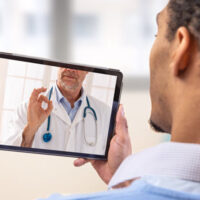Telehealth And The Risk Of Medical Malpractice

With more and more people living in remote places with limited healthcare, telehealth has been on the rise in recent years. It became especially popular during the pandemic, when people avoid doctor’s offices and other crowded places due to the risk of developing COVID.
Telehealth refers to medical care performed remotely, typically performed via video. It may also constitute discussions with a care provider via a phone call, the use of secure messaging systems to send information, and the use of monitoring devices to check on a patient’s condition remotely.
When a doctor or other medical professional provides care without seeing you in person, that constitutes a telehealth visit. Telehealth can be very helpful, allowing for long-distance patient and physician contact, care, reminders, education, advice, intervention, and monitoring. Doctors can also monitor or prescribe medications for recurring conditions such as skin conditions and migraine headaches. With telehealth, doctors can easily check in on patients after surgery.
Increasingly, telehealth is used to diagnose and treat urgent care issues such as coughs and stomach ailments.
Even though there is decreased concern regarding COVID, doctors still prefer telehealth for cost reasons. They can treat many more patients in a day through telehealth visits, reducing office overhead. This reduces costs for insurance companies as well.
As you can see, telehealth can be beneficial in many ways. However, it can also be risky. Without a doctor in the same room as you to perform an assessment, the possibility of medical malpractice increases.
Common Medical Malpractice Issues
Here are some common issues associated with telehealth:
- The biggest risk of medical malpractice is misdiagnosis. Misdiagnosis of cancer, stroke, and infection account for 45% of malpractice claims. The biggest reason for this is technology. A poor connection or glitchy audio or video can alter what the patient is saying, which can affect the diagnosis. Both the provider and patient can prevent this by testing audio and video ahead of time. Do the appointment somewhere with a high-speed internet connection. Ask questions to ensure you understand what the other person is saying.
- Data security. Data security is another risk. Technology is necessary for telehealth, so many doctors rely on software to treat their patients. They may also incorrectly store patient data, which means it can be easily hacked. You can decrease these risks by updating the software frequently and protecting the software with firewalls.
- Privacy protection. HIPAA compliance is required for telehealth and other virtual medical services. It’s important for those accessing patient information to have full knowledge of HIPAA rules and protections. There should be detailed procedures for handling patient data as well as annual HIPAA training.
Seek Help for Your Medical Malpractice Case
Medical malpractice can occur even if you are not in the same room with your doctor. While telehealth is becoming more popular, it’s risky.
Learn more from a Dade City & Zephyrhills medical malpractice attorney from Mander Law Group. Medical malpractice cases can be complex, but we can assess your situation and help you understand your legal options. To schedule a free consultation, call (800) 557-0411 or fill out the online form.
Source:
openloophealth.com/blog/telehealth-and-the-risks-of-medical-malpractice